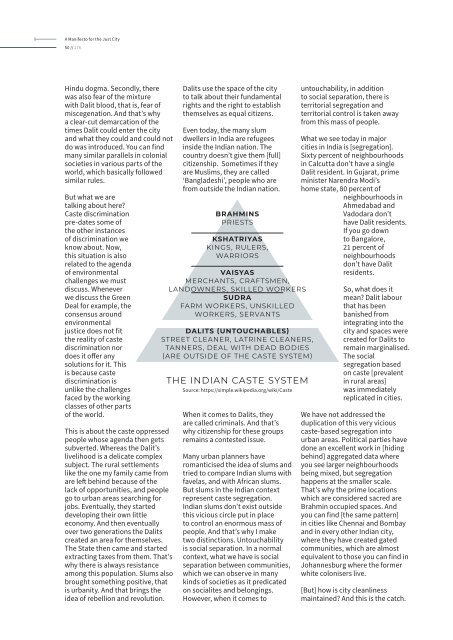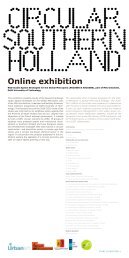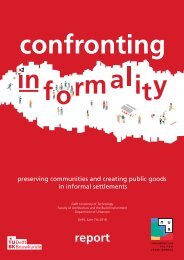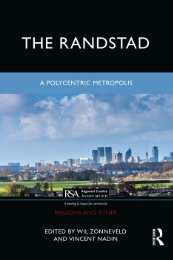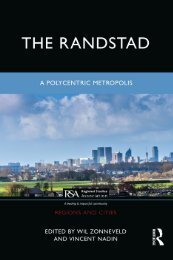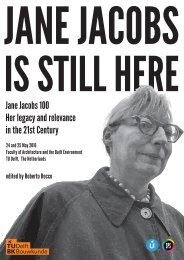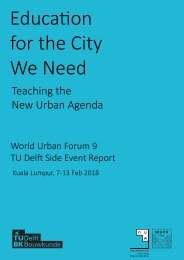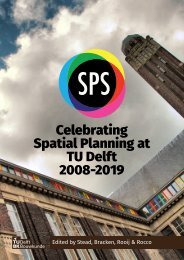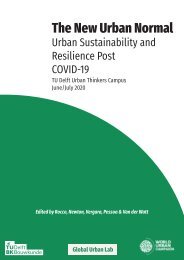A Manifesto for the Just City
On Monday 29 MARCH at 18:00 (CET/Amsterdam), TU Delft launched the Book "A Manifesto for the Just City", with texts by a number of guests and 43 manifestos written by students from 25 universities from all over the world. A “Manifesto for the Just City” comes in the wake of the realisation that socio-spatial justice is a crucial dimension for sustainability transitions. Growing inequality and the erosion of the public sphere undermine the social and political structures required to fight climate change, pandemics and other systemic shocks. With this book, we have sought to encourage students to formulate their own visions for the Just City and for a just transition. This book is result of an Urban Thinkers Campus organised between 9 and 30 November 2020. The Urban Thinkers Campus (UTC) model is an initiative of UN-Habitat’s World Urban Campaign, conceived in 2014 as an open space for critical exchange between stakeholders and partners. It aims to promote debate and action on sustainable and inclusive urbanization upholding the principles and guidelines contained in the New Urban Agenda, launched at Habitat-III in 2016 in Quito, Ecuador.
On Monday 29 MARCH at 18:00 (CET/Amsterdam), TU Delft launched the Book "A Manifesto for the Just City", with texts by a number of guests and 43 manifestos written by students from 25 universities from all over the world.
A “Manifesto for the Just City” comes in the wake of the realisation that socio-spatial justice is a crucial dimension for sustainability transitions. Growing inequality and the erosion of the public sphere undermine the social and political structures required to fight climate change, pandemics and other systemic shocks. With this book, we have sought to encourage students to formulate their own visions for the Just City and for a just transition.
This book is result of an Urban Thinkers Campus organised between 9 and 30 November 2020. The Urban Thinkers Campus (UTC) model is an initiative of UN-Habitat’s World Urban Campaign, conceived in 2014 as an open space for critical exchange between stakeholders and partners. It aims to promote debate and action on sustainable and inclusive urbanization upholding the principles and guidelines contained in the New Urban Agenda, launched at Habitat-III in 2016 in Quito, Ecuador.
You also want an ePaper? Increase the reach of your titles
YUMPU automatically turns print PDFs into web optimized ePapers that Google loves.
A <strong>Manifesto</strong> <strong>for</strong> <strong>the</strong> <strong>Just</strong> <strong>City</strong><br />
50 // 276<br />
Hindu dogma. Secondly, <strong>the</strong>re<br />
was also fear of <strong>the</strong> mixture<br />
with Dalit blood, that is, fear of<br />
miscegenation. And that’s why<br />
a clear-cut demarcation of <strong>the</strong><br />
times Dalit could enter <strong>the</strong> city<br />
and what <strong>the</strong>y could and could not<br />
do was introduced. You can find<br />
many similar parallels in colonial<br />
societies in various parts of <strong>the</strong><br />
world, which basically followed<br />
similar rules.<br />
But what we are<br />
talking about here?<br />
Caste discrimination<br />
pre-dates some of<br />
<strong>the</strong> o<strong>the</strong>r instances<br />
of discrimination we<br />
know about. Now,<br />
this situation is also<br />
related to <strong>the</strong> agenda<br />
of environmental<br />
challenges we must<br />
discuss. Whenever<br />
we discuss <strong>the</strong> Green<br />
Deal <strong>for</strong> example, <strong>the</strong><br />
consensus around<br />
environmental<br />
justice does not fit<br />
<strong>the</strong> reality of caste<br />
discrimination nor<br />
does it offer any<br />
solutions <strong>for</strong> it. This<br />
is because caste<br />
discrimination is<br />
unlike <strong>the</strong> challenges<br />
faced by <strong>the</strong> working<br />
classes of o<strong>the</strong>r parts<br />
of <strong>the</strong> world.<br />
This is about <strong>the</strong> caste oppressed<br />
people whose agenda <strong>the</strong>n gets<br />
subverted. Whereas <strong>the</strong> Dalit’s<br />
livelihood is a delicate complex<br />
subject. The rural settlements<br />
like <strong>the</strong> one my family came from<br />
are left behind because of <strong>the</strong><br />
lack of opportunities, and people<br />
go to urban areas searching <strong>for</strong><br />
jobs. Eventually, <strong>the</strong>y started<br />
developing <strong>the</strong>ir own little<br />
economy. And <strong>the</strong>n eventually<br />
over two generations <strong>the</strong> Dalits<br />
created an area <strong>for</strong> <strong>the</strong>mselves.<br />
The State <strong>the</strong>n came and started<br />
extracting taxes from <strong>the</strong>m. That’s<br />
why <strong>the</strong>re is always resistance<br />
among this population. Slums also<br />
brought something positive, that<br />
is urbanity. And that brings <strong>the</strong><br />
idea of rebellion and revolution.<br />
Dalits use <strong>the</strong> space of <strong>the</strong> city<br />
to talk about <strong>the</strong>ir fundamental<br />
rights and <strong>the</strong> right to establish<br />
<strong>the</strong>mselves as equal citizens.<br />
Even today, <strong>the</strong> many slum<br />
dwellers in India are refugees<br />
inside <strong>the</strong> Indian nation. The<br />
country doesn’t give <strong>the</strong>m [full]<br />
citizenship. Sometimes if <strong>the</strong>y<br />
are Muslims, <strong>the</strong>y are called<br />
‘Bangladeshi’, people who are<br />
from outside <strong>the</strong> Indian nation.<br />
BRAHMINS<br />
PRIESTS<br />
KSHATRIYAS<br />
KINGS, RULERS,<br />
WARRIORS<br />
VAISYAS<br />
MERCHANTS, CRAFTSMEN,<br />
LANDOWNERS, SKILLED WORKERS<br />
SUDRA<br />
FARM WORKERS, UNSKILLED<br />
WORKERS, SERVANTS<br />
DALITS (UNTOUCHABLES)<br />
STREET CLEANER, LATRINE CLEANERS,<br />
TANNERS, DEAL WITH DEAD BODIES<br />
(ARE OUTSIDE OF THE CASTE SYSTEM)<br />
THE INDIAN CASTE SYSTEM<br />
Source: https://simple.wikipedia.org/wiki/Caste<br />
When it comes to Dalits, <strong>the</strong>y<br />
are called criminals. And that’s<br />
why citizenship <strong>for</strong> <strong>the</strong>se groups<br />
remains a contested issue.<br />
Many urban planners have<br />
romanticised <strong>the</strong> idea of slums and<br />
tried to compare Indian slums with<br />
favelas, and with African slums.<br />
But slums in <strong>the</strong> Indian context<br />
represent caste segregation.<br />
Indian slums don’t exist outside<br />
this vicious circle put in place<br />
to control an enormous mass of<br />
people. And that’s why I make<br />
two distinctions. Untouchability<br />
is social separation. In a normal<br />
context, what we have is social<br />
separation between communities,<br />
which we can observe in many<br />
kinds of societies as it predicated<br />
on socialites and belongings.<br />
However, when it comes to<br />
untouchability, in addition<br />
to social separation, <strong>the</strong>re is<br />
territorial segregation and<br />
territorial control is taken away<br />
from this mass of people.<br />
What we see today in major<br />
cities in India is [segregation].<br />
Sixty percent of neighbourhoods<br />
in Calcutta don’t have a single<br />
Dalit resident. In Gujarat, prime<br />
minister Narendra Modi’s<br />
home state, 80 percent of<br />
neighbourhoods in<br />
Ahmedabad and<br />
Vadodara don’t<br />
have Dalit residents.<br />
If you go down<br />
to Bangalore,<br />
21 percent of<br />
neighbourhoods<br />
don’t have Dalit<br />
residents.<br />
So, what does it<br />
mean? Dalit labour<br />
that has been<br />
banished from<br />
integrating into <strong>the</strong><br />
city and spaces were<br />
created <strong>for</strong> Dalits to<br />
remain marginalised.<br />
The social<br />
segregation based<br />
on caste [prevalent<br />
in rural areas]<br />
was immediately<br />
replicated in cities.<br />
We have not addressed <strong>the</strong><br />
duplication of this very vicious<br />
caste-based segregation into<br />
urban areas. Political parties have<br />
done an excellent work in [hiding<br />
behind] aggregated data where<br />
you see larger neighbourhoods<br />
being mixed, but segregation<br />
happens at <strong>the</strong> smaller scale.<br />
That’s why <strong>the</strong> prime locations<br />
which are considered sacred are<br />
Brahmin occupied spaces. And<br />
you can find [<strong>the</strong> same pattern]<br />
in cities like Chennai and Bombay<br />
and in every o<strong>the</strong>r Indian city,<br />
where <strong>the</strong>y have created gated<br />
communities, which are almost<br />
equivalent to those you can find in<br />
Johannesburg where <strong>the</strong> <strong>for</strong>mer<br />
white colonisers live.<br />
[But] how is city cleanliness<br />
maintained? And this is <strong>the</strong> catch.


